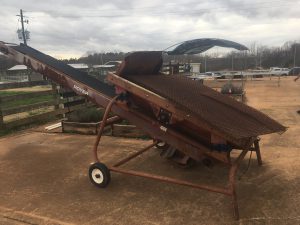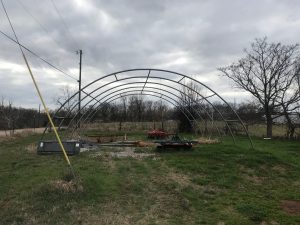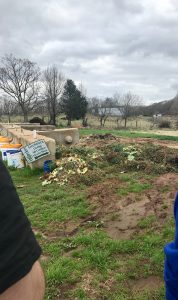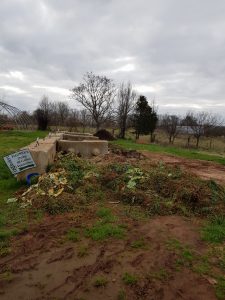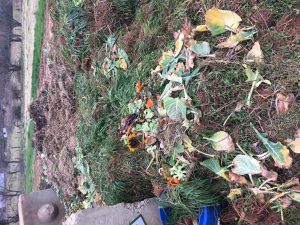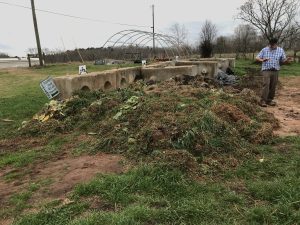- This picture is of a rusted compost sifter that was recently donated to the UGArden.
- The thing I noticed the most about this compost sifter was how worn down it was. While our guide assured us it was in good working condition and shared his excitement to finally have a sifter at the UGArden, his jealousy at the equipment the University had for their mass composting system was extremely apparent. He compared each aspect of their composting system to the University’s and wished that the UGArden had that much funding and was able to work as efficiently.
- When I look at this picture, I feel sad that the UGArden does not get the funding and new equipment that it deserves. The garden works very hard to utilize natural techniques to create large healthy crops without fertilizers and GMOs and they should be provided with equipment that aids them in reaching their goal.
- I think when anyone looked at this picture, they would immediately recognize it as some sort of farming equipment. I do not think they would be able to know the object’s function until someone told them what it was, but it clearly appears to have been around for a long time.
- I think this picture shows how complicated it is to properly compost. In order to create nutrient-rich soil from organic garbage, one must be careful of the material placed in the mix- the carbon vs nitrogen balance must be correct- the temperature of the pile must be high enough, the area must not be too dry or too wet, and there must be a consistent and meticulous stirring and sifting of the material. Most of all though, the process takes time. Just as the sifter rusts over time, the garbage will eventually change and produce something new- a nutrient rich soil that can replace environment damaging fertilizers.
UGArden Reflection
This is a picture of the boss at UGArden holding a broad fork. In the foreground are some raised beds with various plants in them. In the background is an old compost sifter.
One thing I notice in this picture is the raised beds. At my house in Memphis, we have a large garden in which we grow all kinds of vegetables. Quite a few years ago, my dad noticed we were having trouble retaining the good soil that we worked hard to create. We had drainage problems in the area that the garden was, so my dad decided that we would construct raised beds in order to retain and maintain the soil that we created.
This picture makes me think about my summer working on an organic vegetable farm in Tennessee. We would do a lot of the same things that the man in the picture described. We operated on a similar scale as this farm and we grew a lot of the same crops, so we had a lot of the same problems that they have. I think someone would interpret this photo as a man giving a lecture about gardening at first, and that person would be right.
When I look at this picture, I feel happy. It reminds me of working on a garden and using a broad fork to loosen up the soil without tilling. In high school, my friend and I built a high tunnel similar to the one that he showed us and we didn’t have enough resources to buy a tiller, so we used a broad fork to essentially till the soil in between plantings.
I think this picture is about how we can do small things to positively affect the world around us. At UGArden, they are conscious of the impact they have on the environment. Because of this, they do everything they can to be as sustainable as possible, reducing their collective carbon footprint, and leaving the world better than they found it. – John Kutteh
UGArden: Promoting Growth by Limiting Moisture
- In this picture there is a cloudy sky over dead trees and grass that is green in some spots and dead in others. Power lines stand to the left while some unknown equipment stands underneath the tunnels.
- I was surprised first at the lack of visible plant-life. That is to say, the fantasized notion of a garden promises fruits and vegetables that are always visible. Of course that isn’t true and logically I must’ve known that, but the subconscious expectations were subverted.
- Initially, looking at this picture, one may see the tunnel as an arch meant to give support to vine-based plants or others that cannot support themselves. I personally thought so on first look, thinking back to a similar arch that leads to my front door at home.
- Looking at this picture, I’m surprised at the amount of knowledge that is in the world that I may never know. Within the world of gardening, there is so much scientific knowledge that ranges across many disciplines. Presumably, every field requires such in depth knowledge, which seem daunting.
- This picture, I think, shows the disconnect between expectation and reality that many people have when it comes to farming and things they don’t know about in general. The tunnel in the picture is actually used to keep moisture of plants, allowing moisture regulation to prevent the growth of mold and other diseases. To an extent, this is a counterproductive method of gardening, as rain should theoretically promote the most amount of growth!
UGArden – Saloni Gupta
In this picture, at first glance, I see a large, jumbled pile filled with grass cuttings, leaves, orange and banana peels, and a sunflower. However, what I notice is the beginnings of the beneficial natural process of composting. What seems like an ordinary pile is actually being recycled into dark, nutrient-rich productive soil (pictured in the back) which I think is so incredible. This compost pile is productively using raw materials to give back to the soil. It is housing invisible organic matter and beneficial bacteria and putting it all back into the system. Many natural processes take a long time, so; it is kind of mind-boggling to think that the UGArden uses composting to transform a six-month process into a just a few weeks while still contributing to and enriching the soil. This picture makes me think about people taking the environment into their own hands, understanding its needs, and genuinely wanting to help and nourish it. It makes me think about the fresh vegetables and fruits I eat. The reason why I am able to truly enjoy my food and retain the nutrients I need is because the fruits and vegetables are growing in quality rich soil due to composting. It also makes me think about how easy composting can be based on the materials shown in the picture. Since fruits such as oranges and bananas are already part of my regular diet, it is hard to think of an excuse to not put the peels into a composting bin than opt for the trashcan. I think this picture is about hard work, care, and awareness. The people of UGArden have truly put in genuine hard work because they care about the environment. They understand the benefits of composting and the effects it can have on the soil and then later on to the fruits and vegetables we eat to get our nutrients from. It makes people, like me, aware of composting and why it is important to look after the soil and environment since we depend our whole lives on it.
UGArden Reflection
In this picture, I see a collection of food scraps and plant matter that will soon be decomposed and become compost. I also see concrete dividers for the different stages of compost. Lastly, I see a pile of finished compost in the back. I noticed in this picture that there is a long and intricate process for composting.
This picture makes me think about how the UGArden takes composting seriously. Additionally, this picture helps me realize that everyone in the UGArden community cares so much about composting and healthy soil that they all come together and make one collective effort to compost. At first glance, the average person might think that this is just an image of dead crops/waste. They might also think that the compost in the back is just a pile of regular dirt.
When I look at this picture, I feel optimistic for the future of agriculture. I think that if composting started to become the norm everywhere, there would be much more significant yields of crops and healthier soil.
I think that this picture is mostly about the long and complex process of composting, and how a plethora people come together in an effort to ensure that compost is successfully created at UGArden. The fact that composting is a long process is stressed even more by the large pile of compost in the back, which is several years worth of composting.
UGarden Julianna Mallette
In this picture, I see something that the workers at the UGarden are truly proud of, and rightfully so.
I see a heap of old vegetables and clippings from a garden, but I know that this heap will turn into compost that will benefit the garden itself in the future, and I see nature at work. In the back, you can see the pile of compost that took years in the making, and something that they have worked hard to create and maintain, so that really stuck out to me.
This picture makes me think about my great grandparents’ farm, and how their compost looked so different in comparison. My family didn’t work nearly as hard as the members of UGarden do to care for their compost, so maybe that’s why my family grows timber now, instead. At first glance, I think someone would interpret this as just a heap of trash, but this trash is so important for the environment that they are keeping at the garden.
When I see this picture, I feel good, because I know that someone cares. The man in the picture obviously takes a lot of pride in what they do there, or else why would he want to take the time out of his day to talk to us about it? I feel like this is a progressive step in agriculture.
I think this picture is about what we will see in the future. What is just a green pile now, will become rich and brown, and good for the soil once again. It’s also about the future of farming, and how we can take steps to ensure we are trying our best to replenish the earth that we depend on for all of our food.
UGarden
Unfortunately I was unable to join the UGarden tour, but I really wanted to go. I was very curious if it was more of a garden or more of a farm. After reading through the UGarden site, I now know that it’s a little bit of both. It’s very much a place for students to not only grow organically, but it also encourages experimentation.
I was very touched by their mission statement because they not only plan to learn to grow organically and sustainably, but they also help those who can’t get fresh produce through UGA’s very own Campus Kitchen organization. In addition, some produce goes to local schools for sampling in the cafeterias.
It’s extremely refreshing to see students take initiative and preserve/work on this garden. I think a lot of us could take notes from them since we often don’t think twice about where we get our food.
UGArden Reflection
“In this picture I see what every average american sees, a pile of garbage.” This is what I would have said had you asked me the day before our excursion. Today, however, I see something much different. In this photo, I see the future. I see my next meal; the carrots that I munch on at lunch and the lettuce that I put on my sandwich at dinner. What looks like the end of life, in this photo, is in fact just the beginning, thanks to composting. For many, like me, the process and benefits of composting elude us. Yet, when I look at this picture, all I can think about is how much beneficial organic material we throw away everyday. For example, if you look closely, you can see the remains of some orange peel amid the pile. I can only imagine how many banana peels, orange peels, broccoli stems, and other useful material I dump in the trash everyday that is shipped off to a landfill, lost among the pizza boxes and milk cartons. This picture makes me feel lousy knowing how much good material I’ve let waste in these landfills when there was an easy outlet of disposing it right outside my backdoor. This picture is meant as a message. It means to tell us that there is another outlet besides landfills. An outlet that will actually put life back into the earth rather than just taking it away. We need to transform our relationship with earth from a parasitical one to beneficial one.
UGArden Reflection – Greg Gruschow
In this picture, I see a pile of compost and one of the gardeners explaining the function of compost. When I look at this picture, I notice how most of it looks like ordinary dirt and grass, with the exception of a couple crops towards the left side of the pile. This picture makes me think about the many methods farmers use to help the environment and be more efficient when growing crops. When I look at this picture, I feel a slight urge to research ways I can help the environment myself. I think this picture is about the many different plants and other things that can go into composting.
UGArden
In this picture, I see a man who is really passionate about soil. And there’s nothing wrong with that–he’s being environmentally conscious by doing so. I think this picture is really cool because it not only captures the compost itself, but also a professor who has spent hours upon hours of his time doing the composting (and best of all, in the middle of explaining the ups and downs of the temperature of said compost). This picture makes me think about one main thing (stay with me on this one): Could you increase the productivity of composting by putting all of your organic material in a blender? That’s what, sadly, I was thinking about throughout the professor’s entire presentation. And to my surprise, he actually answered my wild internal question, albeit indirectly–there was a machine that sliced and diced organic material to speed up the composting process. So, when I look at this picture, I think about the innovations that keep popping up in the agriculture industry. However, I think this particular picture is about something more specific: the determination of one professor to do his part, whether it be turning over the piles of dead leaves via tractor or throwing egg shells into a homemade compost bin away from UGArden. No matter where he is, he tries to make a difference.

